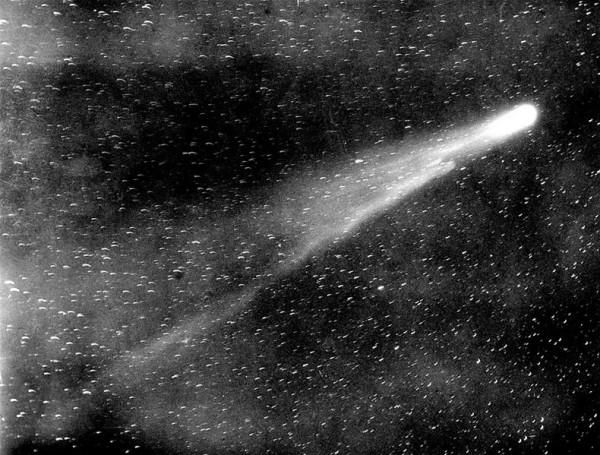Hubble Space Telescope Finds Distant Planet With Comet-Like Tail
| KJ Belonio | | Jun 25, 2015 06:26 PM EDT |
(Photo : Wikimedia Commons) In the recent findings published in the journal Nature, astronomers have discovered a bizarre and distant planet with a comet-like tail.
Astronomers have recently discovered a bizarre and distant planet with a comet-like tail. Discovered through NASA's Hubble Space Telescope, the newfound Neptune-size planet has also an immense stream of Hydrogen gas flowing behind it, giving it a comet-tail effect.
Like Us on Facebook
The distant planet is surrounded by a giant cloud of Hydrogen gas dubbed as "The Behemoth," which was detected by the Hubble Space Telescope and Chandra X-ray Observatory. It is considered as a rare and unique kind ever discovered by the astronomers. According to NBC News, the odd and comet-like planet is known as GJ 436b.
Hubble Space Telescope's newly-discovered planet is orbiting a red dwarf star and is about 22 times as huge as the Earth. Due to extreme radiation from the star, the hydrogen is evaporating from the warm Neptune-sized planet thus giving it a comet-like tail feature, Space Coast Daily has learned.
"This cloud is very spectacular, though the evaporation rate does not threaten the planet right now," lead study author and University of Geneva Observatory astronomer David Ehrenreich said.
Located about 33 light-years from Earth in the constellation Leo, exoplanet GJ 436b is dubbed to be a "Warm Neptune" because of its size and it is much closer to its star than Neptune is to the Sun, ABC Science noted.
Ehrenreich added that the cloud of gas that surrounds GJ 436b has a circular head with a diameter of about 1.8 million miles, which is five times the width of the host star or about half that of the sun. The length of its tail, on the other hand, is uncertain, because the research team's observation do not cover it entirely. However, their computer models suggest it could be about 9.3 million miles long.
"I was astonished by the mere size of the cloud of gas escaping from the planet," Ehrenreich added.
Aside from what the Hubble Space Telescope has recently detected, prior research has already predicted that other gas giants should be emitting comet-like tails, based on how hot they must be due to their proximity to their stars. However, GJ 436b is the first exoplanet for which the comet-like tail feature is confidently detected.
As per the previous study taken from the data documented by NASA's Kepler Space Telescope, there has been an indirect evidence of a rocky world that appears to be disintegrating around its host star, creating a comet-like tail of material behind the planet. And that study was made possible by the observation of the light scattering from the planet's host star.
Meanwhile, scientists estimated that GJ 436b is currently blowing off up to 1,000 tons of gas per second, Live Science reported. This means that the exoplanet is currently losing about 0.1 percent of its atmosphere every billion years, a rate that is far too slow to deplete its atmosphere in the lifetime of its parent red dwarf star.
Furthermore, researchers have estimated that the Hubble Space Telescope-detected exoplanet could have lost 10 percent or more of its atmosphere during its first billion years when the star was more active in its infancy.
The recent findings, which is published in the journal Nature, could provide new clues and insight as to how some rocky terrestrial planets are formed.
TagsHubble Space Telescope, planet, comet, Cosmos, outer space, discovery, Science
©2015 Chinatopix All rights reserved. Do not reproduce without permission
EDITOR'S PICKS
-

Did the Trump administration just announce plans for a trade war with ‘hostile’ China and Russia?
-

US Senate passes Taiwan travel bill slammed by China
-

As Yan Sihong’s family grieves, here are other Chinese students who went missing abroad. Some have never been found
-

Beijing blasts Western critics who ‘smear China’ with the term sharp power
-

China Envoy Seeks to Defuse Tensions With U.S. as a Trade War Brews
-

Singapore's Deputy PM Provides Bitcoin Vote of Confidence Amid China's Blanket Bans
-

China warns investors over risks in overseas virtual currency trading
-

Chinese government most trustworthy: survey
-

Kashima Antlers On Course For Back-To-Back Titles
MOST POPULAR
LATEST NEWS
Zhou Yongkang: China's Former Security Chief Sentenced to Life in Prison

China's former Chief of the Ministry of Public Security, Zhou Yongkang, has been given a life sentence after he was found guilty of abusing his office, bribery and deliberately ... Full Article
TRENDING STORY

China Pork Prices Expected to Stabilize As The Supplies Recover

Elephone P9000 Smartphone is now on Sale on Amazon India

There's a Big Chance Cliffhangers Won't Still Be Resolved When Grey's Anatomy Season 13 Returns

Supreme Court Ruled on Samsung vs Apple Dispute for Patent Infringement

Microsoft Surface Pro 5 Rumors and Release Date: What is the Latest?










